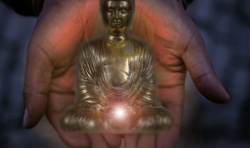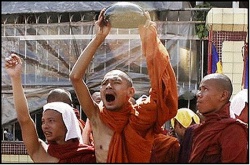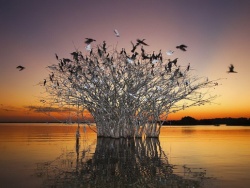Sala grove
The Malla capital of Kujsinara was, in the Buddhas day, a place of small importance.
Ananda contemptuously refers to it as a little wattle and daub town in the midst of a jungle, a branch township, quite unworthy of being the scene of the Buddhas Parinibbana.
But the Buddha informs Ananda that it was once Kusavati (q.v.), the mighty capital of Kusa and Mahasudassana.
This shows that the Mallas had, at first, a monarchical constitution, but in the sixth century B.C. they were regarded, together with the Vajjis, as a typical example of a republic (sangha, gana) (M.i.231).
The chief Mallas administered the state in turn.
Those who were free from such duties engaged in trade, sometimes undertaking long caravan journeys (DA.ii.569).
The name of a people and their country.
The country is included in the sixteen Mahajanapadas of the Buddhas time.
The kingdom, at that time, was divided into two parts, having their respective capitals in Pava and Kusinara.
The Mallas of Pava were called Paveyyaka Malla, those of Kusinara, Kosinaraka.
That these were separate kingdoms is shown by the fact that after the Buddhas death at Kusinara, the Mallas of Pava sent messengers to claim their share of the Buddhas relics (D.ii.165). Each had their Mote Hall.
In the Sangiti Sutta we are told that the Buddha, in the course of one of his journeys, came with five hundred followers to Pava and stayed in the Ambavana of Cunda the smith.
A new Mote Hall, called Ubbhataka, had just been completed for the Mallas of Pava, and the Buddha was invited to be the first to occupy it that it might be consecrated thereby.
The Buddha accepted the invitation, and preached in the Hall far into the night.
It was also at Pava that the Buddha took his last meal, of Sukaramaddava, at the house of Cunda (D.ii.126f).
From there he went to Kusinara, and there, as he lay dying, he sent Ananda to the Mallas of Kusinara, who were assembled in their Mote Hall to announce his approaching death.
The Mallas thereupon came to the Upavattana Sala grove where the Buddha was, in order to pay him their last respects.
Ananda made them stand in groups according to family, and then presented them to the Buddha, announcing the name of each family.
After the Buddhas death, they met together once more in the Mote Hall, and made arrangements to pay him all the honour due to a Cakkavatti.
They cremated the Buddhas body at the Makutabandhana cetiya, and then collected the relics, which they deposited in their Mote Hall, surrounding them with a lattice work of spears and a rampart of bows till they were distributed among the various claimants by Dona (D.ii.166).
The Mallas, both of Pava and Kusinara, erected thupas over their respective shares of the relics and held feasts in their honour (D.ii.167).


